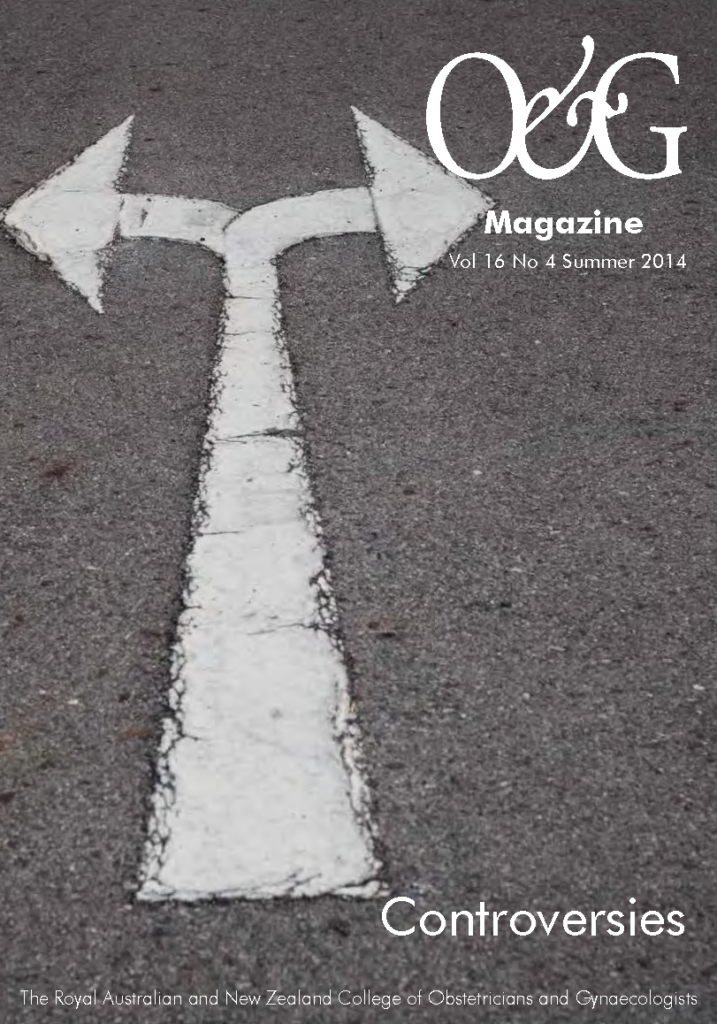Q&a attempts to provide balanced answers to those curly-yet-common questions in obstetrics and gynaecology for the broader O&G Magazine readership, including Diplomates, Trainees, medical students and other health professionals.
Q
‘A 50-year-old para 2 has been using transdermal oestrogen with Mirena IUCD providing endometrial protection since the onset of premature menopause en years ago. She tried stopping it a year ago, but had a resurgence of vasomotor symptoms. She would like to continue HRT for as long as possible. Apart from a BMI of 28, she has no medical or family history of note. She has not had a mammogram for more than five years as she has made a fully informed decision to avoid mammography, believing its risks outweigh the benefits. Given the early onset of menopause, what advice should I give her about when to discontinue HRT? Should we continue prescribing HRT to a patient who declines breast screening?’
a
Physicians who look after menopausal women are usually very concerned about weighing up the long-term risks and benefits of HRT. In contrast those who suffer significant hot flushes mostly want their symptoms treated so they function and can sleep at night. In the 1990s HRT was hailed as a treatment that most, perhaps even all, postmenopausal women should take for many years. Then, after the dramatic release of the breast cancer data from the Women’s Health Initiative (WHI) on 10 July 2002, the pendulum swung in the opposite direction. Fear to prescribe HRT gripped many doctors and some women with severe menopausal symptoms suffered.
A significant minority of women will have severe menopausal symptoms for many years (some forever) and so, for these women, the clinical decision usually comes down to what is the safest way of giving HRT long term. There have been some key studies and a number of excellent reviews of the risks and benefits of long-term HRT.1-6 A short summary of the findings of these reviews follows.
For many healthy women, most types of HRT (oral, transdermal, tibolone) are safe up to the age of 60 years. In the WHI cohort, those who were under 60 years of age and on oral HRT (Premarin-Provera) had a significantly lower risk of death than the control group. Those over 60 years of age on oral HRT had a similar risk of death to the control group. From a woman’s perspective, most of the concern about using HRT is focused on breast cancer risk. In WHI, the group on combined oral HRT had an increased risk of eight per 10 000 women per year after five years of usage. This was statistically significant using uncorrected data, but not when corrected for multiple comparisons. Also, in the same cohort, there were eight fewer other cancers per 10 000 women per year.
We will shortly examine the breast cancer issue in more detail, but it is also important to point out that for those women who ‘flush forever’, the main risk of long-term HRT as they move beyond 60 years of age is actually venous (DVT, pulmonary embolism) and arterial thrombosis (stroke and other atherosclerotic disease). In this respect, transdermal oestrogens (patches, gels, creams, implants) are safer than orals because they avoid hepatic first-pass. In one major review5 there was no excess of thrombosis with oestrogen patches. In contrast, in WHI, there was a steady increased risk of embolism with age for those on oral HRT.
Returning to the breast cancer issue, it is important to consider all the patient’s risk factors. There are convenient Australian (www. seemyrisk.com/) and US breast cancer risk calculators available
(www.cancer.gov/bcrisktool/). Relevant to our patient, menopause under the age of 45 years reduces breast cancer risk in later life (as does delivering your first baby under the age of 25 years). It can be very helpful to calculate a patient’s breast cancer risk over the next ten years; on and off HRT. Patients are often surprised how small an effect HRT has on their breast cancer risk.
One interesting finding from WHI was that those subjects on unopposed oestrogen (hysterectomised subjects) had a significantly lower risk of developing breast cancer. It is beyond the scope of this short article to outline the likely explanations, but it has focused a lot of breast basic research on the progestin rather than oestrogen. It has also piqued interest in novel delivery systems for progestins/progesterone to selectively protect the endometrium from the well-known stimulatory effects of oestrogen and minimise the systemic exposure of the body to progestins. Our patient has a Mirena device in place that will very effectively protect her endometrium, while her systemic exposure to the synthetic progestin will be minimal.
Another interesting approach from Europe has been the suggestion to use twice weekly progesterone pessaries. In one small study, subjects were using oestradiol patches changed twice weekly and on the day they changed the patch, they inserted a 100mg progesterone pessary high in the vagina.7 This approach offered endometrial protection with barely detectable progesterone levels in blood.7 Crinone gel four per cent (45mg progesterone) twice weekly has also been used in this way.8 There is an abundant literature dating back to the 1990s describing the direct delivery of drugs from the upper vagina to the uterus. Both Crinone (eight per cent) and progesterone suppositories (100mg) are available in Australia and New Zealand (PBS approved for IVF).
Finally, I shall discuss the issue of screening mammography raised by our patient. Unknown to most Australians, there has been a huge (and at times, heated) debate in Europe (especially in the British Medical Journal) about the benefits and risks of screening mammography.9-12 It came to a head when a Danish group showed that for the first time in 20 years, screening mammography no longer impacted breast cancer death rate in that country.9 This study and others9-13 have two major explanations for this surprise finding.
First is that breast cancer treatments have steadily improved over the last 20 years. In most Western countries the death rate from breast cancer has been falling. In Australia, between 1994 and 2011, the age-standardised mortality rate for breast cancer in women decreased by 30 per cent (from 30.9 deaths per 100 000 women in 1994 to 21.9 deaths per 100 000 women in 2011. See http://canceraustralia.gov.au/affected-cancer/cancer-types/breast-cancer/breast-cancer-statistics).
Second is the problem of over-diagnosis. In 1997, Welch and Black13 reviewed autopsy studies and found 1.3 per cent had invasive breast cancer and nine per cent had breast DCIS. Most of these lesions were too small to be detected by mammography. However, it seems clear that many of these small tumours never progress and some may even regress spontaneously. More recently, Prof Welch has nicely summarised the problem10 – ‘over-diagnosis refers to the detection of abnormalities that will never cause symptoms or death during a patient’s lifetime. Over-diagnosis of cancer occurs when the cancer grows so slowly that a patient dies of other causes before it produces symptoms or when the cancer remains dormant (or regresses). Because doctors don’t know which patients are over-diagnosed, we tend to treat them all. Over-diagnosis therefore results in unnecessary treatment.’
It is interesting to note that to date there has been no public discussion of this controversial subject in Australia.
Our patient is using oestrogen patches and has a Mirena device fitted. She is using arguably our safest HRT system. Assuming she has been informed about the risks and benefits of her HRT, it would seem reasonable for her to continue on HRT for another five-to-ten years, if she wishes and then to try to wean off the patches during the cooler months. If severe symptoms keep returning, she may be in that significant minority of women (around 10–15 per cent) who have severe flushes forever. Non-oestrogen treatments such as clonidine, selective serotonin reuptake inhibitors and gabapentin could be discussed (these have their side effects too, of course). I suspect our patient has discovered the European controversy about the risks and benefits of screening mammography and I don’t see how that changes her HRT decision at all.
Thus, I would support her decision to continue on HRT for the moment and not have mammographic screening.
References
- Manson JE, Chlebowski RT, Stefanick ML et al. Menopausal hormone therapy and health outcomes during the intervention and extended poststopping phases of the Women’s Health Initiative randomized trials. JAMA 2013; 310(3):1353-68.
- MacLennan AH. HRT: a reappraisal of the risks and benefits. Med J Aust 2007; 186(12):643-6.
- Langer RD, Manson JE, Allison MA. Have we moved full circle – or moved forward? The Women’s Health Initiative 10 years on. Climacteric 2012; 15:206-12.
- Gompel A, Stanten RJ. Hormone therapy and breast cancer risk 10 years after the WHI. Climacteric 2012; 15:241-9.
- Canonico M, Plu-Bureau G, Lowe GDO et al. Hormone replacement and the risk of venous thromboembolism in postmenopausal women: systematic review and meta-analysis. Br Med J 2008; 336:1227-31.
- Fournier A, Berrino F, Riboli et al. Breast cancer risk in relation to different types of hormone replacement therapy in the E3N-EPIC cohort. Int J Cancer 2005; 114:448-54.
- Fernandez-Murga L, Hermenegildo C, Tarin JJ et al. Endometrial response to concurrent treatment with vaginal progesterone and transdermal oestrogen. Climacteric 2012; 15:455-9.
- De Ziegler D, Ferriani R, Moraes LAM, Bulletti C. Vaginal progesterone in menopause: Crinone 4% in cyclical and constant combined regimens. Hum Reprod 2000; 15 (supplement): 149-58.
- Jorgensen KJ, Zahl PH, Gotzsche P. Breast cancer mortality in organized mammography screening in Denmark: comparative study.Br Med J 2010; 340:1241-7.
- Welch HG. Overdiagnosis and mammographic screening. Br Med J 2009; 339:182-3.
- McPherson. Should we screen for breast cancer? Br Med J 2010; 341:233-5.
- Editorial. Breast screening: the facts – or maybe not. Br Med J 2009; 338:446-8.
- Welch HG, Black WC. Using autopsy series to estimate the disease “reservoir” for ductal carcinoma in situ of the breast: How much more breast cancer can we find? Ann Int Med 1997; 127: 1023-8.






Leave a Reply